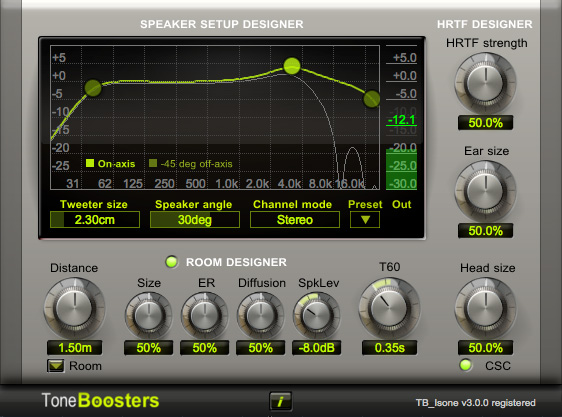[1] How do you know what happens in my head? You can only speak about your head. ...
[2] Listening to music that is not processed with a crossfeed algorithm sounds unnatural and annoying, especially bass.
[3] Yes, it does approximate speakers to a certain degree. Many crossfeed plugins have these additional features: ... This is an example ...
[4] This thread is completely hi-jacked by crossfeed-haters.
1. Agreed.
2. No it doesn't! Don't you really mean that to
YOU it "sounds unnatural and annoying, especially bass"? If you do not explicitly specify that is how it sounds to YOU PERSONALLY, then you are making a blanket statement that covers everyone (including me). And the obvious response to that assertion is: "How do you know what happens in my head? You can only speak about your head.". You are therefore effectively contradicting yourself! ... Just to be clear, despite the fact I've stated it a number of times: Listening to music on headphones without crossfeed does not sound natural to me but listening with crossfeed does not sound natural to me either. Furthermore, listening with speakers/monitors does not sound natural to me either and the reason none of the playback scenarios sounds natural to me is because none of it is natural! Stereo itself is an illusion (that isn't natural) and the music recordings themselves are not natural. Almost without exception, music recordings are made by layering multiple different aural locations and/or perspectives, which would only be natural if you had multiple different ears which were simultaneously in different locations.
3. That is NOT an example of a crossfeed plugin! Crossfeed is the act of taking the signal from one channel and "feeding" it (or part of it) to the other channel. The example you gave would only be a crossfeed plugin if you turned off all those "additional features", IE. Turn off the HRTF and "Room Designer" features. Your example is INCORRECT, it is NOT an example of a crossfeed plugin, it is an example of a "Binaural Room Simulator" plugin!
4. Firstly, I wouldn't say I'm a crossfeed hater. It doesn't work for me personally, I personally don't like it and I choose not to use it but I don't hate it or state that everyone else should/must hate it too. Secondly: So, instead of the thread being "hi-jacked by crossfeed haters", you want to hi-jack it as a Binaural Room Simulator fan boy? The thread title is NOT "to-binaural room simulate-or-not ..."!
My system is 5.1, but I'm told that Atmos allows you to place a sound object anywhere within left right, front back and top bottom parameters. That would be true 3D.
That would be true 3D but Atmos does NOT allow you to do that and therefore is NOT true 3D. Atmos allows you to place a sound anywhere in the horizontal plane (left/right, front/back) and can theoretically do that more precisely than 5.1 (although only in a cinema), as it it less reliant on the stereophonic illusion (phantom positioning). Atmos additionally provides ceiling speakers, allowing for height information
BUT, with two limitations:
Firstly, the soundfield is effectively between the existing horizontal plane of (5.1) speakers and the higher vertical plane of the ceiling speakers. Using your terminology, Atmos allows you to place a sound object anywhere within left right, front back and top
middle parameters! NOT within "top bottom parameters", a sound cannot be positioned below the horizontal plane of the (existing 5.1) speakers. In other words, Atmos theoretically provides a hemispherical soundfield, rather than the spherical soundfield that would be required for "true 3D". I know Atmos (and other similar formats) are marketed as 3D sound formats but that's just marketing, a bit like unlimited data plans that are limited!
Secondly, positioning a sound anywhere within that hemispherical soundfield is arguably only theoretically possible rather that possible in practice. This is because there are many positions within that hemisphere which would effectively rely on a double phantom position; a phantom position between the horizontal plan of speakers, PLUS a phantom position between that horizontal phantom position and a vertical phantom position. In practice, that would be a highly unstable position, even if all the speakers were perfectly phase aligned at a particular listening position, a stereophonic illusion on top of a stereophonic illusion could change (or be entirely destroyed) by a relatively small change in head position relative to any of the speakers. On the other side of the coin, would we actually perceive a change or destruction of this unstable illusion? Our localisation ability in the vertical plane is many times weaker than in the horizontal plane anyway. My educated/experienced guess would be that it would depend on several factors, probably the most important of which is how/if that aural illusion is supported by our vision (IE. Is there a visual cue in the film which indicates the position of the sound and if so, how obvious is it). Another factor would be our position relative to ALL the speakers and another would be an individual's perception. Due to the fact that this localisation may not be perceived as intended by significant portions or the audience and the potential phase issues it could create, these positions within the hemispherical soundfield are typically avoided when creating a mix (that is, typically avoided for static positions, "passbys", sounds passing through those positions are fine).
G





















